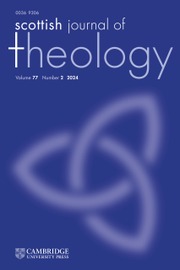-
- Get access
- Contains open access
- ISSN: 0036-9306 (Print), 1475-3065 (Online)
- Editor: Professor Ian A. McFarland Candler School of Theology|Rita Anne Rollins Building|1531 Dickey Drive|Atlanta, Georgia 30322 USA
- Editorial board
Latest articles
March Article of the Month
Karl Barth on election and nationhood: Christological reflections from 1936
Shao Kai Tseng
Abstract
This article probes into Karl Barth's theology of nationhood set forth in Gottes Gnadenwahl, a volume on the doctrine of election published in November 1936. I will attend to his use of Hegelian terms and concepts to demonstrate his refutation of secularist and immanentist reinterpretations of the Christian doctrines of election and providence under the Enlightenment principle of historical progress by modern German thinkers, most notably Hegel. As Barth sees it, Hegel was largely at fault for having provided theological and philosophical justifications for the rise of Germany's mystical nationalism in the name of German Christianity. Using Hegelian language, Barth insists against Hegel that election is God's predetermination of human existence in Christo. Rather than negating nationhood altogether, Barth's repudiation of nationalism is intended to stress that nationhood is an external basis of the communion of the elect, and that the election of the community is the internal basis of nationhood.
Religious studies blog

-
From the Author; Astrobiology and the Christian Doctrine with Revd Prof Andrew Davison
- 13 March 2024,
- The Revd Prof Andrew Davison is the Starbridge Professor of Theology and Natural Science, holding the professorship endowed by the novelist Susan Howatch.…...

-
The importance of open access publishing for the arts and humanities
- 20 December 2023,
- Between 2012 and 2014, I held a two-year Wellcome Trust Research Leave Award (WT096499AIA) for a project on women surgeons in Britain, 1860-1918.…

-
New to Cambridge in 2024: New Blackfriars
- 12 December 2023,
- Cambridge University Press is pleased to announce that it will publish New Blackfriars from January 2024, in partnership with The Provincial Council of the...

Facebook